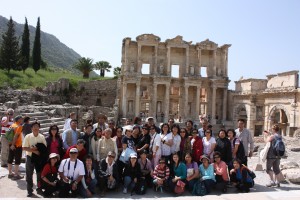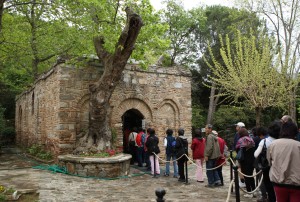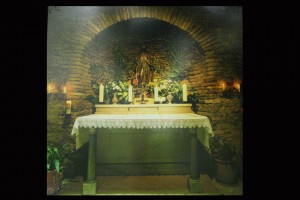Reflections on a Pauline Pilgrimage to Turkey [4]
“I do not cease to give thanks for you, remembering you in my prayers, that the God of our Lord Jesus Christ, the Father of Glory, may give you the spirit of wisdom and revelation in the knowledge of him” [Ephesians 1:16-17].
[1] A group photo at the ancient city of Ephesus. [2] Mother Mary’s House, Ephesus. [3] Mother Mary’s Shrine inside the House. Photo © Teresa Sim.
Ephesus evokes powerful emotions – good, strong, spiritual emotions!
This is the one place where Mother Mary, St John and St Paul come together, in a very powerful way, to touch pilgrims on three counts: one, to console us; two, to reveal to us visions of Christ and of the Church, and three, to challenge us in Christian living in the reality of the twenty-first century.
[1] The Consolation
A very dear friend in Kuching, fighting a relapse of cancer the last three years, has made a request to a few of us in the group. “Please pray for me at Mother Mary’s house in Ephesus.” He asked ever so gently, but you could feel the eagerness in his voice as he made the request.
He was there in person at Mother Mary’s house two years ago. We were told that the moment his knees touched the floor, he just broke down and cried like a child – a child suffering not only in the body ravaged by cancer, but a child suffering from the frustrations of life, from a litany of unfinished symphonies in life, a child desperately seeking the love, the compassion and the consolation of his heavenly Mother. Such is the strong spiritual umbilical cord that connects Catholics to Mother Mary.
No wonder when we got inside the little house, we saw the couple of dozen pilgrims who had their turn to go in were all somber, some standing and some kneeling, but everyone was clearly in an intensely prayerful mood. Many were visibly in tears, and some were audibly crying, even very audibly in that tiny space. On our part, we were blessed with indescribable bliss as we bent our knees, overwhelmed with uncontrollable emotions and yet at the same time with a mysteriously peaceful sensation flooding our being.
Perhaps, as we did, pilgrims to this final dwelling place of Mother Mary felt a special presence of the Blessed Mother. Pope John Paul II understood this instinct very well and has articulated it, saying: “Mary’s motherhood is manifested in a particular way in the places where she meets us: her dwelling places, places in which a special presence of the Mother is felt.”
Instinctively, we touched the walls as we imagined her prayers reverberating round the room all those years. And, in utter confidence and immense gratitude, we lifted up our friend’s prayer, and those of our own, as well as those of the pilgrims praying right there with us in the same space and time, trusting in her maternal concern and her intercession with her Son.
Outside Mother Mary’s House, our minds travelled back to incidents of encounter with Christians from other denominations, and in some cases with Catholics who have been influenced by their Protestant friends. Not only did they have difficulties accepting the Blessed Virgin, they could be outright rude to her and, by extension, to us who are devoted to her and have recourse through her. And to them all, we ask firmly, but with love:
- What has Mary done to you that you should despise and reject her, when all that she has done was to give you Jesus Christ?
- What has Mary done to you that you should treat her with such insolence, when all that she has done was to deliver to you the Son of God?
- What has Mary done to you that you should treat her with such contempt, when all that she has done was to say yes to God in obedience to His plan of salvation for humankind and thus your salvation and, in the process, incur immense personal suffering?
- What has Mary done to you that you should treat her with such disrespect, when you know very well that she is the mother of your Lord who in His compassion would do what she asked to work His very first miracle at Cana to help out a married couple whose wine has run out, even though His “hour has not yet come”?
- What has Mary done to you that you should be so bad towards her, when all that she has done was to give you, as she does the rest of humanity, one singular counsel, “Do whatever He [Jesus] tells you”?
As Christians of whatever denomination, we must surely know how important that counsel is. It is the exact same counsel given by God the Father up on the Mountain of Transfiguration. There, the Father’s voice spoke from beyond the clouds to Peter, James and John, “This is my beloved Son. Listen to him” [Mark 9:7]. “Listen to him” – “Do whatever he tells you.” Mother Mary, in obedience to God, always leads us to Jesus her Son. Seeing Jesus transfigured high atop Mount Tabor has meaning and value only if it leads the apostles and now all disciples of Christ Jesus to listen obediently to Him.
“This is my beloved Son; listen to him.” Here now is the supreme endorsement of the Son by his Father. “Listen to him.” Yes, listen, even when He says things that you don’t like, things that you do not yet understand. It is a confirmation of all that has gone on before – the real identity of who Jesus is and the reliability of everything that He says will happen to him and what is expected of the disciples.
On Mount Tabor, Moses and Elijah are both symbolic of what they did: Moses represents the Law and Elijah represents the Prophets; when combined, they symbolize the Old Covenant. Their conversation with Jesus points to Him being the fulfillment of the Covenant. Then God the Father claims Jesus as His own beloved Son to whom we are to listen – and that means obey and do.
To listen, obey and do is precisely what Catholics do when they pray the Rosary . Just as the Angel Gabriel addressed Mary “Hail Mary, full of grace, the Lord is with you!” [Luke 1:28], so we do the same as we pray the “Hail Mary,” adding Elizabeth’s prophetic greeting: “Blessed are you among women, and blessed is the fruit of your womb!” [Luke 1:42]. Scriptures then recount Mary’s prophecy in her Magnificat: “Henceforth, all ages shall call me blessed” [Luke 1:48]. And that’s what Catholics throughout the ages have been doing, in obedience to the Word of God – greeting her, and affirming Scriptural prophecy, and calling her blessed. Even the Muslims in Turkey and throughout the world who come here as pilgrims, can respectfully and lovingly accept Mary as “Meryam Anna” – Mother Mary. Why can’t we Christians, regardless of denominations, do the same?
[2] The Revelation of Visions of Christ and the Church
According to tradition, the Apostle John brought Mary with him to Ephesus where she lived out her final years.
Among the most important Christian monuments in Ephesus is The Church of Mary (Meryem Kilisesi). It is also known as the Double Church, one aisle being dedicated to the Virgin and the other to St. John. Probably built around the middle of the fourth century, this was a vast church and the first to be dedicated to the Blessed Virgin. This fact is regarded as evidence that there was a very early tradition that accepted that Mary spent her last years in Ephesus. This church was also the venue of the Third Ecumenical Council – the Council of Ephesus in AD 431. Amongst other matters, the Council:
- Confirmed the Virgin as the mother of Jesus’ human and divine natures, on account of the hypostatic union – the two natures cannot be divided;
- Condemned the teaching of Nestorius, bishop of Constantinople, who held that the Virgin could only be the mother of the human aspect of Jesus;
- Reconfirmed that the Virgin was Theotokos, the Mother of God, and not just Christotokos, the Mother of Christ;
- Accepted that the Virgin lived in Ephesus with St John.
Mary appears only twice in the Gospel of St John, first at the beginning of Jesus’ public ministry at the wedding feast at Cana [John 2:1-12], and second at the end of Jesus’ ministry at the foot of the Cross [John 19:26-27].
At Cana, Mary revealed Jesus Christ through her maternal concern. When the wine ran out at the wedding feast, our Mother of compassion brought the problem to her Son and whispered to him real gently, “They have no more wine.”
Has the wine run out in your life? Do you lament over unfinished symphonies in life?
In her maternal concern, Mother Mary knows our needs and she wants to help us resolve them. And she knows the best way to do so is to take these problems to her Son. For she knows her Son. She knows the power of her Son. She knows the compassionate heart of her Son, the heart of the Saviour of the world which first beat in her womb, close to her very own heart! And she trusts the heart of her Son. And she wants her Son to do ordinary things in extraordinary, supernatural ways. And then, here is the key, she will always turn around and tell us: “Do whatever He tells you.”
But Cana is not just about a human wedding feast. When Jesus said, “My hour has not yet come,” he was pointing towards Calvary, the hour of his Cross. “And I, when I am lifted up from the earth, will draw all men to myself.” [John 12:32]. The “hour” is the hour of the glory of the cross. And, on the cross, Jesus gave his mother to John, the beloved disciple, to be His mother and he gave John to Mary to be her son. At the foot of the cross, the beloved disciple represents all of us, the followers of Jesus, His beloved. In Mary in the New Testament, by Raymond Brown et al., an ecumenical venture of top-notch biblical scholars from different Christian denominations, the authors point out that:
- This episode in John’s crucifixion account is of central importance for the evangelist’s view of Mary. This scene which comes after Jesus’ ministry points to the future, the era of the disciples who will come after him.
- The primary significance of the scene was that, in giving the beloved disciple to Mary as her son, and Mary to the disciple as his mother, Jesus brought into existence a new community of believing disciples.
- But Mary, who in the Cana episode had been distinguished from the disciples, now becomes the model of disciple par excellence, and so becomes herself a model of belief and discipleship.
You see, these scholars know that Mary’s claim to fame was her faith. That was what Elizabeth said of her at the Visitation: “And blessed is she who believed that there would be a fulfillment of what was spoken to her from the Lord” [Luke 1:45]. We know the battle cry of the Protestant Reformation was “Faith alone! – Sola fide.” But Catholic theology has always insisted the same thing, that it is impossible to earn God’s favour by our good works, but rather we receive his love as a pure gift through faith. Looking at Mary, Catholics appreciate that faith involves abandoning oneself to God, and willingly submitting to his will. She surrendered her plan for her life, and yielded to God’s plan, trusting that he would do what he said. And in Paul’s expression, this is “the obedience of faith” [Romans 16:26]. At the foot of the Cross, she is the model of perfect faith and Catholics honour her for that.
And all is grace of course. Mary knew that. She knew that even her faith was a gift, a grace. That’s why she responded to Elizabeth’s praise with the humble yet exuberant and deeply heartfelt Song of Praise known as the Magnificat: “My soul magnifies the Lord, and my spirit rejoices in God my Savior” [Luke 1:46-55]. All praises accorded to her were lifted right back to God, the source of her greatness! The official Catholic teaching is absolutely clear on this. The Second Vatican Council made it clear that true Marian devotion lies in the imitation of her virtues, particularly her faith (Lumen Gentium, 67). It is not about chasing after apparitions and begging for cures, important though those things certainly are. First, the Council stressed, Marian devotion is about imitating Mary’s virtues, as a child of God, a believer of Jesus Christ.
Like the Apostle John, we are to take Mary into our hearts and our homes. Whenever we do that, we will hear her say, “Do whatever Jesus tells you.”
[3] The Challenges for Christian Living
Ephesus was notable as an important center for early Christianity.
After spending eighteen months planting the church of God in Corinth, St Paul moved to Ephesus where he stayed for two years. Here, he wrote his First Letter to the Corinthians. Tradition has it that when Paul was in prison in Rome, he wrote The Letter of Paul to the Ephesians. In both letters, the theme of the Church as the Body of Christ comes through very strongly.
In First Corinthians, Paul dealt with ten pastoral problems as relevant 2,000 years ago as they are today. Without over stretching the point, one may say that throughout the letter Paul is suggesting to the Corinthians what it means to live as the Body of Christ both within the faith community and in relation to the outside world. So, very early into the letter, as he deals with the problem of divisions within the faith community, Paul raises the question of what it means to be Church. Paul’s teaching is highly relevant today as he exhorts the early Christians neither to go the way of privilege-claims nor to make status-claims, and certainly not to make claims of tribal-alliance and group-superiority. To be Church, and be workers in God’s vineyard, quite simply means one plants, another waters, but God alone gives the growth. “He who plants and he who waters are equal, and each shall receive his wages according to his labour” [1 Cor 3:6-8]. No wonder Pope Benedict says repeatedly that the laity are equal co-participants, not just collaborators, of the priests, in the life, work and mission of the Church. There is an equal demand on priests and laity to face up to this biblical demand. But are Catholics listening?
Paul continues with his contribution to the faith community’s self-understanding as the Body of Christ, first articulated so brilliantly in 1 Cor 12, in the Epistle to the Ephesians in what Andrew Walls calls “the Ephesian Moment”. This is basically the coming together for the first time of Jewish and Gentile Christians, from two communities historically separated. This coming together entailed the breaking down of the wall of separation and that was brought about only by the blood of Christ (Eph 2:13-18).
The message for us all is simple and yet stunning: “The very height of Christ’s full stature is reached only by the coming together of the different cultural entities into the body of Christ. Only ‘together,’ not on our own, can we reach his full stature,” Walls writes. In the one body, Jews and Gentiles “belong together”, like bricks for the construction of the one holy temple in the Lord (Eph 2:19-22).
It is stunning in today’s reality because, unless one insists on behaving like an ostrich and sticking one’s head in the sand, one must admit that the dominant narrative about the church today is intense polarizations. Fortunately, that is not the whole story. One cannot but be profoundly encouraged as well to see trail-blazing efforts of bridge-building and unprecedented works by small beloved communities where we least expect to find them, interrupting and tearing down great divides.
Two elements of the Ephesian Moment warrant our attention.
- First, cultural diversity is built within the vision of the church as the one body of Christ. Paul, however, does not celebrate the mere fact of cultural diversity, but their coming together (as bricks of a single building; as parts of the same body). It is the “coming together” of the different cultural elements that reveals the “very height of Christ’s full stature.”
- Secondly, the acid test as it were of that coming together is the meal table. At the meal table, there shall be neither status-claims, nor privilege-claims, and certainly none of the arrogant and Spirit-stifling “we are the ones to decide” assertions. The meal table that once symbolized the ethnic and cultural divisions, must now become the hallmark of Christian life. We have already seen that in Antioch, where followers of the odd “Way” were for the first time called “Christians”. Their coming together created a new “we” that required a new name. No one had needed such a term when they existed vehemently apart as only Jews [today, the chosen and the anointed?] and Gentiles [today, the common people in the pews?].
Today, slogans like “we are the Church” are of course beautiful as far as slogans go. But, in spirit and truth, what do we need to do to flesh them out with real substance, lest they are reduced to empty slogans?
Copyright © Dr. Jeffrey & Angie Goh, August, 2011. All rights reserved.
You are most welcome to respond to this post. Email your comments to us at jeffangiegoh@gmail.com. You can also be dialogue partners in this Ephphatha Coffee-Corner Ministry by sending us questions for discussion.



